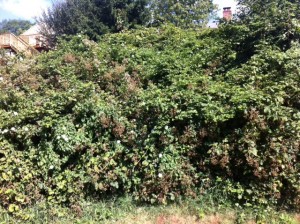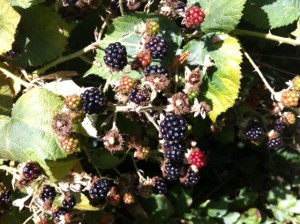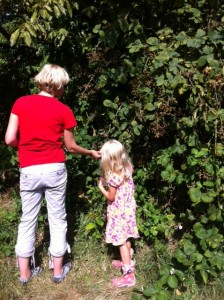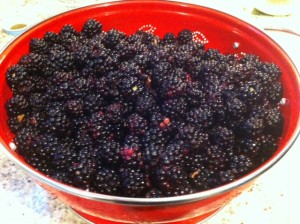Himalayan blackberries – the noxious weed that makes fantastic pie
Posted on August 22nd, 2012 by Ecoyards


Blackberries ripening.
It’s August in Seattle, and that means one of the most hated noxious weeds in Northwest becomes one of the most endeared. Summer means a lot of things in Seattle, but picking luscious blackberries (and other fruits) ranks among one of our favorites. For about 11 months out of the year, when you’re not eating them in pies, Himalayan blackberries pose a royal headache. They spread rapidly and densely, are difficult to control and cause loads of damage to other vegetation, trees and the environment. Yet for several weeks during from late summer to autumn, they bear such complex sweet-tart fruits that it’s hard not to love them, especially served with vanilla ice cream.

Picking berries. All photos by Ecoyards.
For a few weeks now, I’ve been keeping an eye on blackberry stands as I’ve driven or walked by alley ways, vacant lots and streets, checking to see if the fruit’s color to ripen from red to black. There’s a massive stand of blackberries in the field of an abandoned nearby school that produced hundreds of fruit last year; so on a recent afternoon, my friend Lisa, her daughter, and I hit that school field with several buckets in tow. We each had pie or muffins on the mind when we began picking in the blazing sun, enduring prickly thorns and bramble-induced scratches as we tried to reach for the juiciest, plumpest, darkest berries. Plenty of fruit hadn’t yet ripened from red to black. But, it was a productive day nonetheless. At the end of an hour, our fingers were stained with deep purple and we each had picked about 8 cups, enough for both blackberry pie and muffins!
It’s hard to call a plant with such tantalizing berries a noxious weed, but Himalayan blackberry ranks high as a damaging, invasive weed. In Washington state, they’re considered a Class C Noxious Weed. Homeowners aren’t required to control this widespread weed, but it is recommended that they be controlled in natural lands and protected wilderness. Himalayan blackberry spreads fast in open areas, like vacant lots, forest lands and stream channels. One plant inventory of Seattle’s public forests found that Himalayan and evergreen blackberry were the most invasive species in those forests.


Blackberry pie.
Himalayan blackberry outcompetes native vegetation; grows thick and dense, with canes reaching about 20-40 feet long; and prevents the establishment of trees like the Pacific Madrone or Douglas Firs. Himalayan blackberry, known as Rubus armeniacus, is not native to the Northwest. It’s actually a native of Western Europe (not the Himalayans), according to this factsheet produced by The Nature Conservancy. Experts say it was likely introduced to North America in 1885 as a cultivated crop and naturalized along the West Coast by 1945.
It’s possible to pull the weeds by hand if you have small patches of them. Generally you can take up the entire root ball. Larger, more expansive stands require cutting the canes and then pulling them up by their roots. You can also mow blackberries to keep them under control (cut them when the plant begin to flower, if you’re going to do it only once). You’ll have to keep up the cutting each year, however, otherwise they could grow from the crown even denser and nastier than the year before.
Contact Ecoyards if you need help controlling blackberry plants in your yard.
Filed under:Seattle Landscape Maintenance | Permalink |



